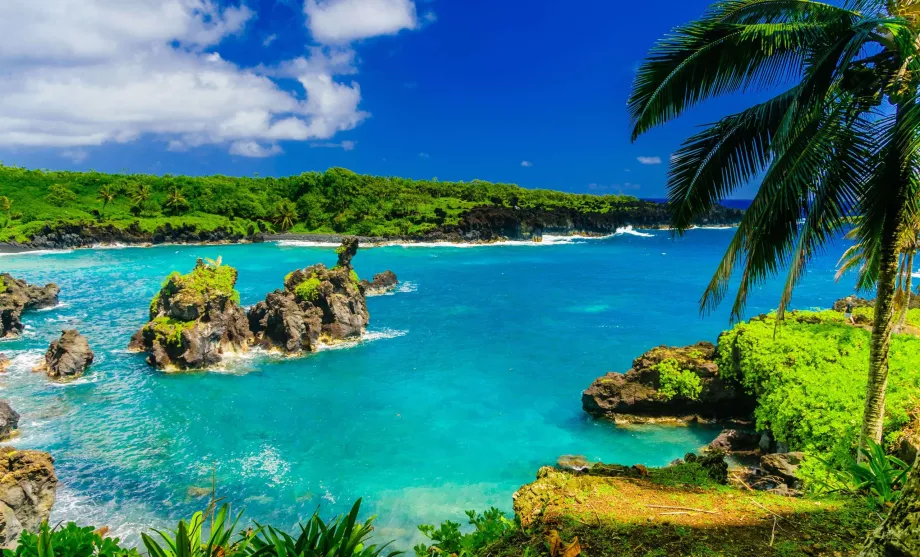Weather in Maui and best time to go

Maui stands out among the Hawaiian Islands in the number of different microclimates.
The landscape is so different that while it rains very often on the eastern part of the island, a few kilometres away in the central valley it only showers a few times a month, only to rain again every day a few hundred metres further up in the mountains. A tropical climate without major fluctuations and especially without a specific rainy season can be enjoyed 12 months of the year.
Buy your flight to Maui in advance
Average temperatures hover around 29°C year-round, and summers and winters are similar in terms of rainfall. It rarely rains for more than 2 hours at a time.
The advantage of Maui's climate is that rain, whether in the form of light showers or violent thunderstorms, is usually very localised and it only takes a 10-minute drive to find yourself in a place with blue skies without a cloud.
Regions of Maui with different climates
The island can be divided into 4 main regions with specific microclimates:
- Central Valley (Kahului-Wailuku, Iao Valley, Northwest Coast) - it's warmer most of the year than elsewhere on the island, the air is drier, and showers are less frequent. The landscape is also drier and less lushly green during the summer.
- Leeward coast (west and south, i.e., Wailea-Makena, Kihei, Lahaina, Kaanapali, Kapalua) - the weather is warmer than on the east and north coasts, with much more sunshine during the day and far fewer showers, although even here they are relatively frequent, but only for very short periods typically at night or early in the morning.
- Windward coast (north and east around the Road to Hana) - a very rainy area with frequent and intense rainfall, but mainly in the form of showers rather than prolonged rain. Temperatures here are also lower than on the rest of the island.
- Inland - the climate here is considerably cooler, due to the increasing altitude and dense forests. It rains quite often, but only in showers, and in the mornings it often forms dense fogs.
Weather on Maui during the year
To give you a clearer idea of whether you should buy a bargain ticket for a particular time of year, we've compiled brief summaries of Maui's weather and temperatures during each month.
Weather in January
January tends to be the coldest month of the year. Average daily temperatures hover around 28°C in the west and south, while the east is cooler with temperatures around 25°C. In January, there are so-called Kona storms, thunderstorms in the south and west, but these are short-lived for only a few tens of minutes and do not affect the holiday much.
It can freeze at night and in the morning on Haleakala volcano, so it is best to drive here during the day when there is little chance of icy roads. Even at the top of the mountain, snowfall is very rare.
The big waves make January an ideal month for surfing. January is also peak whale season in the waters around Maui.
Weather in February
February is very similar to January with average temperatures around 28°C in the west and south, and around 25°C in the east.
Even during February there are less traditional southerly winds bringing occasional thunderstorms to the south and west coasts, but these will have little effect on the holiday.
It can be freezing at night and in the morning on Haleakala volcano, so it is best to drive here during the day when there is little chance of icy roads. Even at the top of the mountain, snowfall is very rare.
The big waves make February an ideal month for surfing. February is also peak whale season in the waters around Maui.
Weather in March
March is generally the rainiest month of the year on Maui. However, there's no need to worry about being caught in prolonged rain and overcast skies.
Rain showers are just like the rest of the year, but during March they tend to be a bit more intense. In the western half of the island it rains mostly at night and in the morning, in the east at any time of the day.
Temperatures climb to 29 °C in the western half of Maui, and hold steady at 25 °C in the east.
Even March is still the month of high surf season with great "big surf" waves especially on the north shore.
Weather in April
April weather on Maui is April weather, with only temperatures around 29 °C and almost all-day sunshine in at least some parts of the island.
April is still one of the main rainy months, however, as is the case on Maui and the Hawaiian Islands in general, if you get caught in the rain, just drive 10 minutes in any direction and you'll find yourself in a sunny tropical paradise.
Big surfing waves still appear in April, as do whales. But the chances of spotting them drop in April.
Weather in May
May is the prelude month between winter and summer. In practice, however, this doesn't mean much to tourists. Average temperatures in the western half of the islands hover around 30°C, with a few degrees lower in the east.
Showers are very common in the east and north (as they are at any time of the year), while the south and west only get a brief shower about once every two days, or at night.
In May, the main surfing season ends in the north and moves to the west and south, but conditions are more for beginners. Even the whales are finally leaving Maui's waters, but for snorkeling enthusiasts, the season of the clearest water is just beginning.
The weather in June
June is the driest month on Maui. There is very little rain on the western half of the island, and even the rainy eastern half gets light showers. Daytime temperatures soar to 30°C (86°F) and often exceed 30°C (86°F) even on the cooler east coast.
However, pleasant strong northerly winds make the air feel cooler, so even in the worst of the heat, being outside is not so unpleasant.
Weather in July
The first month of the holiday season sees the most visitors to Maui of any month of the year.
The dry, hot weather with temperatures around 31°C tempts you to take a typical beach vacation or a trip to the high mountains to cool off. Frequent light showers occur only in the northeast of the island, and are rather rare in the rest of Maui.
Weather in August
August is one of the hottest months with average daily temperatures of 32°C in the western half, or around 28°C in the east.
Many tourists occupy all of Maui's beaches, which rarely see rain showers. Little rain falls across the island, making August an ideal month for a classic summer holiday.
Weather in September
September is the height of summer and is long the hottest month of the year with temperatures around 32°C (32°F), exceptionally they can rise to 36°C (36°F), but extremes are generally very rare in the Hawaiian Islands.
Although September is hurricane season in the Pacific, it is very rare for hurricanes to occur in Hawaii. As a result, September is a perfectly average month for rainfall, with frequent showers in the northeast and exceptional showers in the west and south, where they occur most often early in the morning.
Weather in October
In October, summer slowly fades away and temperatures drop by about one degree to an average of 30 °C.
Rain showers are more frequent, but especially in northeast Maui. Thunderstorms occur about 3-4 times a month in the west and south, but usually pass within 30 minutes.
Weather in November
November's weather is very similar to October's, with average temperatures around 30°C, frequent rain in the northeast and occasional thunderstorms elsewhere on Maui. Rain, however, is a year-round factor that makes vacationing virtually unaffected, and November is no exception.
During November, whales arrive in the waters around Maui, but the chances of spotting them are relatively slim.
Weather in December
December is the first month of winter on Maui, when temperatures drop to around 28°C, with temperatures in the east around Hana hovering around 25°C.
Frequent showers occurring at any time during the day will shower the northeastern part of the island, while the south and west get about once a day and then at night or early in the morning.
In December, the surfing season for experienced athletes begins, as well as the whale watching season.
Book a hotel with an off-season discount
Sea temperature in Maui
Maui's sea water is at a comfortable temperature suitable for swimming year-round.
The ocean is at its coldest in March, when the water temperature is around 23°C, while it is at its hottest in September and October, when it rises to an average of 27°C.
Table of temperatures during the year
Central and western part of the island - Beaches and hill treks
Eastern part of the island - Road trip to Hana
Haleakala - Temperatures for altitudes above 2,500 metres
When to go to Maui
No need to elaborate, you can go to Maui anytime.
There is no specific high season, or rather it lasts 12 months. Still, it's fair to say that during the summer holidays, when the season is in full swing throughout the northern hemisphere, it will be considerably more difficult to find accommodation at even a reasonable price.
However, if you're heading to Maui purely for surfing, kitesurfing or windsurfing, expect the biggest waves between November and March. On the other hand, if your goal is mainly snorkeling, the calmest and therefore clearest seas are during the summer from May to October.
Any questions left?
If you have any questions or comments about the article...

